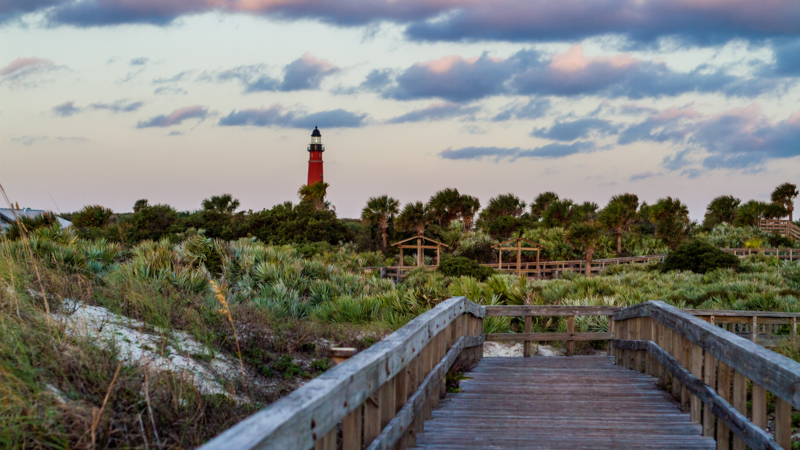
Visit Ponce Inlet to explore many varieties of well-preserved Florida vegetation within this coastal community. Ponce Inlet is home to several native coastal, Florida plants. Read on to discover the flora & fauna, and learn about how Ponce Inlet Lighthouse is continuing to preserve natural spaces.
The Ponce Inlet Lighthouse stands at the end of a barrier island. It is surrounded by the Atlantic Ocean, the Inlet, the Halifax River and to the North, the town of Ponce Inlet and Daytona Beach. Due to different surrounding ecosystems, you will find an intriguing array of native vegetation.
The Ponce Inlet Lighthouse has a nature walk on its grounds. It includes some of the native plants within this Coastal Hammock. A Coastal Hammock or Maritime Forest is characterized by narrow bands of forest that develop on stabilized back dunes of barrier islands, inland from the primary dunes and scrub. These areas are usually elevated land (sometimes just inches) surrounded by wetlands.
Take a walk on the nature trail behind the light station. It retains some of the trees, plants, and resident animals that the keepers of the past would have known. Take time to pause and listen. Imagine what the Lightkeepers might have heard in the late 1800’s. You may find native vegetation like Live Oak Trees, Cabbage/Sabal Palm, Yaupon Holly, Wax myrtle, Southern Bayberry, Florida Lantana, and Simpson’s Stoppers. A variety of songbirds can be found among the trees and shrubs. Raccoon, squirrel, opossum, and armadillo could dwell here or might be found passing through. The state-protected Gopher Tortoise could reside nearby.
Make sure to climb the 203 steps to the top of Florida’s tallest lighthouse. Look around to see the beautiful ecosystems surrounding this magnificent beacon. Discover how our light station has been a part of local history, serving as a landmark and navigational instrument. Make sure to visit the extensive Lens Exhibit Building. You will see well-preserved varieties of glass lenses utilized to aid in navigation over the years.
The Ponce Inlet Lighthouse and Museum has been active in preserving the history of this light station since 1887. It is important to preserve the native vegetation around our coastal area as well. By protecting the native flora and fauna, we help our environment function to maintain its natural beauty and balance. Native plants prevent erosion by maintaining the land’s natural topography. These plants provide homes and food for various animals living here.
At the beach, sand dunes are covered by Saw Palmetto. Many of the native seagrasses are essential in preventing erosion here. Grasses like Sea oats, Saltgrass, Beach sunflower, and Beach morning glory with their unique root systems maintain the sand dunes. These plants provide protection that prevents further erosion. You can take part in the preservation of the dunes and the natural hammock by not walking on the dunes and parking or driving on designated areas while visiting the beaches.
Did you know that the Ponce Inlet Lighthouse and Museum recently acquired the Pacetti Hotel? It is one of the oldest historic places on the coast of Volusia County. The Pacetti Family donated 10 acres of their property to the government to build the Lighthouse. The purchase of this hotel property will greatly enhance the museum’s ability to interpret the Light Station in even more meaningful detail.
Located on 3.5 acres of enchanting property on the banks of the Halifax River, it is directly across the road from the lighthouse. Some of the Live Oak trees on this property have been there since the 1880’s. Ponce Inlet Lighthouse and Museum is currently accepting donations to fund the effort to maintain and restore this important piece of Florida history. For more information on how you can be a part of preserving Florida history go to: https://www.lighthouselocker.org/historic-pacetti-hotel-museum-donations/
If you want to explore even more native vegetation, visit the Ponce Preserve Park. The Park covers 41 acres from the Atlantic Ocean to the Halifax River. You will see several ecosystems during your hike: beach dunes, terraced palmettos, maritime hammock, and wetlands as you near the Halifax River. Visit the Green Mound State Archeological Site and you will find a Live Oak estimated to be 350 years old. The Park is located less than a mile after entering the town of Ponce Inlet. A shaded parking lot is located on Peninsula Drive. For more information go to: /Ponce-Preserve-Park-6-111.html
Sources
Williams, A J. “Native Plants for Coastal Dune Restoration: What, When, and How for Florida.” USDA Natural Resources Conservation Service, USDA.gov, 31 Aug. 2021, www.nrcs.usda.gov/Internet/FSE_DOCUMENTS/nrcs141p2_014913.pdf.